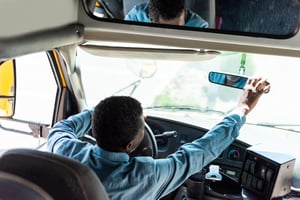Training School Bus Drivers for Worst-Case Scenarios
published on January 14, 2021 by Sonia Mastros
training drivers, school bus drivers, School bus driver trainig
 No one enjoys contemplating the worst things that can go wrong, but when students' lives are on the line, it's important to consider as many scenarios as possible. That's why it's so important to supplement your regular school bus driver training with special lessons focusing on disasters, medical emergencies, criminal activity, and other low-probability/high-risk events that might potentially happen on the road.
No one enjoys contemplating the worst things that can go wrong, but when students' lives are on the line, it's important to consider as many scenarios as possible. That's why it's so important to supplement your regular school bus driver training with special lessons focusing on disasters, medical emergencies, criminal activity, and other low-probability/high-risk events that might potentially happen on the road.
There's no definitive list of everything which could go wrong, of course, but we have some suggestions for elements to add to your school bus driver training program.
Four Worst-Case Scenarios Your School Bus Driver Training Should Cover
1. Onboard Medical Emergencies
What should a bus driver do if a student has a medical emergency or a serious injury occurs onboard? In general, the best option will be to immediately pull to the side of the road, call for emergency assistance, and then provide first-aid, if possible, within the bus. Moving an injured child off the bus increases the danger to them and should only be done in situations where they would be in greater danger while onboard. Otherwise, don't move them until authorities show up.
2. A Fire Breaks Out
Modern school buses have numerous safety features intended to reduce the risk of fire, but it can still happen. Obviously, drivers should always have access to a fire extinguisher near their seat and receive training on how to properly use it. Also, they should know how to evacuate the bus. Consider having on-bus fire drills, complete with students, no different than fire drills within the school building.
3. Keeping Unauthorized People Out
What about if a parent - or some other unauthorized person - tried to force their way onto the bus? The best thing a driver can do is to lock the doors, refuse to open them, and only converse with the intruder via a cracked window. Drivers should also be empowered to simply drive away if they feel uncomfortable about a situation, or are worried the person might become violent.
4. Natural Disasters
Do your drivers know of safe places they can go in the event of dangerous natural threats such as a tornado or earthquake? Every route should have some clearly identified safe zones which a bus could divert to if there's a natural threat to the bus or its passengers. This would include flat, clear areas, as well as covered places the bus could "hide" from threats such as tornados or heavy storms.
It's always better to be prepared and not make use of that preparation than to be caught without a plan! What school bus driver training does your district provide to cover emergency situations? Let us know in the comments below!



